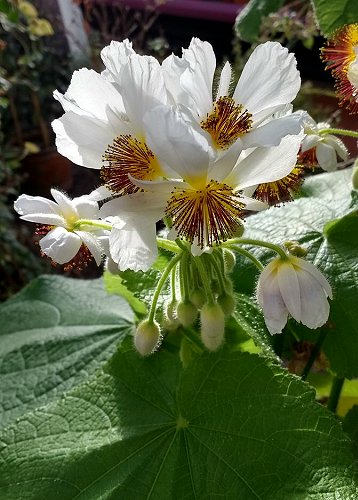
|
|
African Hemp
(Sparrmannia africana).
|
African Hemp - Sparrmannia africana
Sparrmannia africana (African hemp, African
linden) is a species of flowering plant in the family Malvaceae, native to open woodland in
Africa, South Africa and Madagascar. It is one of up to seven species in the genus
Sparrmannia. The genus name is after Anders Sparrman.
Sparrmannia africana is a large, much branched, bushy soft-wooded evergreen shrub or tree with a rounded
habit, usually up to around 4 m but it can reach up to 8 m. The branches are
soft, and young branches are covered in stiff, bristly hairs. The leaves are
large, up to 270 x 210 mm or more, heart-shaped, with 3, 5, 7 or 9 veins from the
base. The margin is toothed. The leaves often have 3, 5, 7 or 9 lobes but are usually entire near the
inflorescence. The leaves are softly textured, covered in short, bristly hairs on both
sides. This can cause some people discomfort
The flowers are white with a mass of yellow and red-purple stamens in the centre, produced in
10-20-flowered umbels towards the ends of the branches. In bud, the flowers are white to greenish white and
drooping, and the outer surface of the sepals and the pedicels (flower stalks) are covered in short bristly
hairs. The pedicel lifts up to about 45° as the flower opens to release white petals that open wide and then reflex
fully, exposing the central mass of stamens. When spent, the petals and sepals close up again and by now the pedicel is standing straight
up.
Much of the attraction of this flower is in the puff of brightly bicoloured
stamens. Many free stamens form the central mass but not all of them are fertile. The outer stamens are yellow with purple tips and are
sterile, while the inner ones, stained reddish-purple with purple tips, are
fertile. The filaments are about 10 mm long and are moniliform in the upper half, meaning that they are regularly constricted resulting in bumps or
knobs, like a string of beads or a knotted rope. They are also sensitive to touch
(see Ecology). Flowering occurs from mid-winter into early summer (June to
November). As with a lot of plants from the southern hemisphere, the books say that its predilection is to flower during the winter months but if happy it will flower almost continuously throughout the summer months
too.
The fruit is a rounded capsule, about 20 mm in
diameter, covered in spiny bristles, that splits open when ripe (dehiscent) to release 3 x 2 mm brown seeds with a finely wrinkled
(rugulose) seed coat.
The genus Sparrmannia is named in honour of Anders Sparrmann (1748-1820) (sometimes rendered as Andrew or
Andreas), Swedish botanist and physician, and pupil of Linnaeus. He was ship's surgeon to
Capt. Ekeberg who brought him to Cape Town in 1772. He accompanied Capt. Cook on his second great
voyage, 1772-75, returned to Cape Town in 1775 and undertook a journey into the interior of South Africa - travelling as far as the Somerset East area in the Eastern
Cape, which is when he must have collected this species - returning to Sweden in 1776.
Sparrmannia species are known for their
haptonasty, rapid movements made by the stamens when they are touched. This adaptation helps in more effective
pollination.
The stamens are sensitive to touch. When an insect, or a finger, bumps or brushes the flower the mass of stamens puffs out even
further. One can watch as the mass opens itself out, rather like watching a hairy caterpillar puff itself up when
threatened. The scientific term for this is haptonasty. In this case it is thought that the movement aids pollination by pushing pollen out and onto the visitor's
body.
With a minimum temperature of 7°C (45°F), S. africana is grown as a houseplant in temperate
regions. It is a popular house plant in Europe, where it is known as African
Hemp. It is not closely related to the true hemp, cannabis.
Source:
https://en.wikipedia.org/wiki/Sparrmannia_africana
http://pza.sanbi.org/sparrmannia-africana
